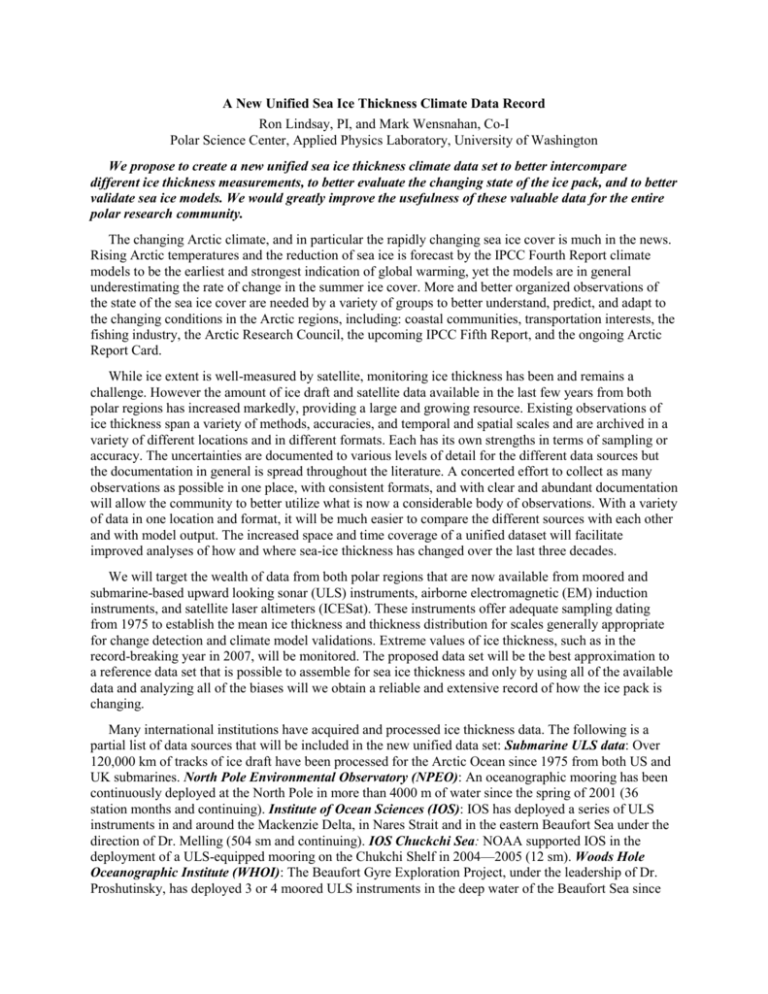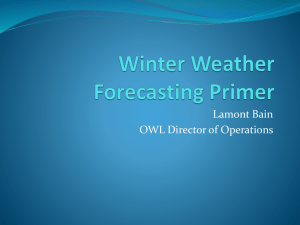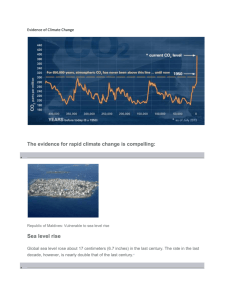Project Description - Polar Science Center
advertisement

A New Unified Sea Ice Thickness Climate Data Record Ron Lindsay, PI, and Mark Wensnahan, Co-I Polar Science Center, Applied Physics Laboratory, University of Washington We propose to create a new unified sea ice thickness climate data set to better intercompare different ice thickness measurements, to better evaluate the changing state of the ice pack, and to better validate sea ice models. We would greatly improve the usefulness of these valuable data for the entire polar research community. The changing Arctic climate, and in particular the rapidly changing sea ice cover is much in the news. Rising Arctic temperatures and the reduction of sea ice is forecast by the IPCC Fourth Report climate models to be the earliest and strongest indication of global warming, yet the models are in general underestimating the rate of change in the summer ice cover. More and better organized observations of the state of the sea ice cover are needed by a variety of groups to better understand, predict, and adapt to the changing conditions in the Arctic regions, including: coastal communities, transportation interests, the fishing industry, the Arctic Research Council, the upcoming IPCC Fifth Report, and the ongoing Arctic Report Card. While ice extent is well-measured by satellite, monitoring ice thickness has been and remains a challenge. However the amount of ice draft and satellite data available in the last few years from both polar regions has increased markedly, providing a large and growing resource. Existing observations of ice thickness span a variety of methods, accuracies, and temporal and spatial scales and are archived in a variety of different locations and in different formats. Each has its own strengths in terms of sampling or accuracy. The uncertainties are documented to various levels of detail for the different data sources but the documentation in general is spread throughout the literature. A concerted effort to collect as many observations as possible in one place, with consistent formats, and with clear and abundant documentation will allow the community to better utilize what is now a considerable body of observations. With a variety of data in one location and format, it will be much easier to compare the different sources with each other and with model output. The increased space and time coverage of a unified dataset will facilitate improved analyses of how and where sea-ice thickness has changed over the last three decades. We will target the wealth of data from both polar regions that are now available from moored and submarine-based upward looking sonar (ULS) instruments, airborne electromagnetic (EM) induction instruments, and satellite laser altimeters (ICESat). These instruments offer adequate sampling dating from 1975 to establish the mean ice thickness and thickness distribution for scales generally appropriate for change detection and climate model validations. Extreme values of ice thickness, such as in the record-breaking year in 2007, will be monitored. The proposed data set will be the best approximation to a reference data set that is possible to assemble for sea ice thickness and only by using all of the available data and analyzing all of the biases will we obtain a reliable and extensive record of how the ice pack is changing. Many international institutions have acquired and processed ice thickness data. The following is a partial list of data sources that will be included in the new unified data set: Submarine ULS data: Over 120,000 km of tracks of ice draft have been processed for the Arctic Ocean since 1975 from both US and UK submarines. North Pole Environmental Observatory (NPEO): An oceanographic mooring has been continuously deployed at the North Pole in more than 4000 m of water since the spring of 2001 (36 station months and continuing). Institute of Ocean Sciences (IOS): IOS has deployed a series of ULS instruments in and around the Mackenzie Delta, in Nares Strait and in the eastern Beaufort Sea under the direction of Dr. Melling (504 sm and continuing). IOS Chuckchi Sea: NOAA supported IOS in the deployment of a ULS-equipped mooring on the Chukchi Shelf in 2004—2005 (12 sm). Woods Hole Oceanographic Institute (WHOI): The Beaufort Gyre Exploration Project, under the leadership of Dr. Proshutinsky, has deployed 3 or 4 moored ULS instruments in the deep water of the Beaufort Sea since 2003 (72 sm and continuing). Norsk Polar Institut (NPI): The NPI has been deploying moored ULS instruments in Fram Strait since 1990, typically two or three at a time (600 sm and continuing). Alfred Wegener Instititute ULS (AWI): AWI has deployed moored ULS instruments in both the Arctic, primarily in Fram Strait, and in the Antarctic, primarily in or near the Weddell Sea (starting in 1990, 383 sm and continuing). University of Alberta Helicopter EM ice thickness: Dr. Christian Haas has made a number of helicopter-borne surveys of the ice thickness with an electromagnetic induction (EM) instrument in both the Arctic and in the Antarctic (~1000 km and continuing). ICESat Satellite data: ICESat laser-altimeter freeboard measurements and ice thickness estimates are available sporadically from February 2003 to the present (~4x106 km and continuing). The ICESat freeboard measurements are accurate to within about 5 cm and the current evaluation of the ice thickness error is about 50 cm. Typical errors in the submarine and moored ULS measurements are on the order of 25 cm. The archive will include both point measurements as acquired from the data providers and average values. The average values will be provide easy access for the change detection and modeling communities and will be for approximately one month of moored ULS data or 50 km of submarine, airborne, or satellite data. (Roughly 50 km of ice passes over a typical mooring site in a month and monthly output is commonly saved in model runs.) A web site will be created to provide easy access to the point data, the averaged data, and the documentation. We will work closely with the NOAA Arctic Research Program at PMEL to see that the data set is well publicized and we plan an EOS article to advertise the archive. The data set will be submitted to the National Snow and Ice Data Center at the conclusion of the project for permanent archival. We are currently part of a NASA project to construct retrospective analyses of the ice and ocean system using a state-of-the-art coupled ice-ocean model operated at the Polar Science Center by Dr. Zhang. The new data set will provide a much-needed evaluation tool for the ice-ocean model used in our attribution analyses and the model will also provide a means of intercomparing data from disparate times and locations. The modeling work will be supported by the NASA project. We are also a member of the Arctic Ocean Model Intercomparison Project (AOMIP) and will be able to introduce the new data set to this wider international group of about ten different coupled ice-ocean modeling efforts and make multiple model-data comparisons. In addition we will construct time- and space-interpolated fields of ice thickness based on a statistical analysis that will document the spatial pattern of the trends in the ice thickness. These fields will be useful for those user groups interested in changes in particular regions. Sea ice thickness is, perhaps, the most important climate state variable that is currently poorly observed, poorly documented, and poorly archived. We as a community can do much better and a unified sea ice thickness data set is an important step forward. The new archive will be a valuable baseline and a continuously growing resource for ongoing work by many groups in understanding, predicting, and adapting to changes in the polar regions.









